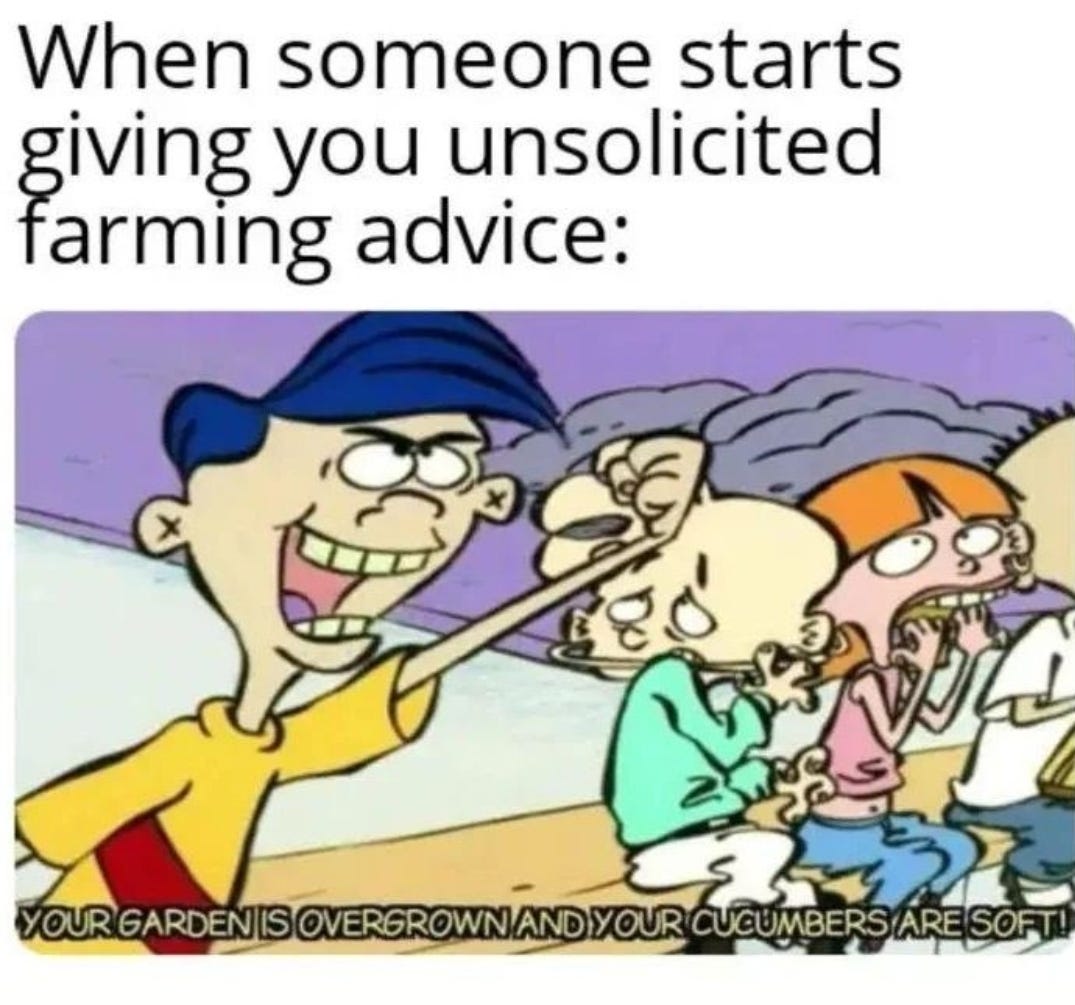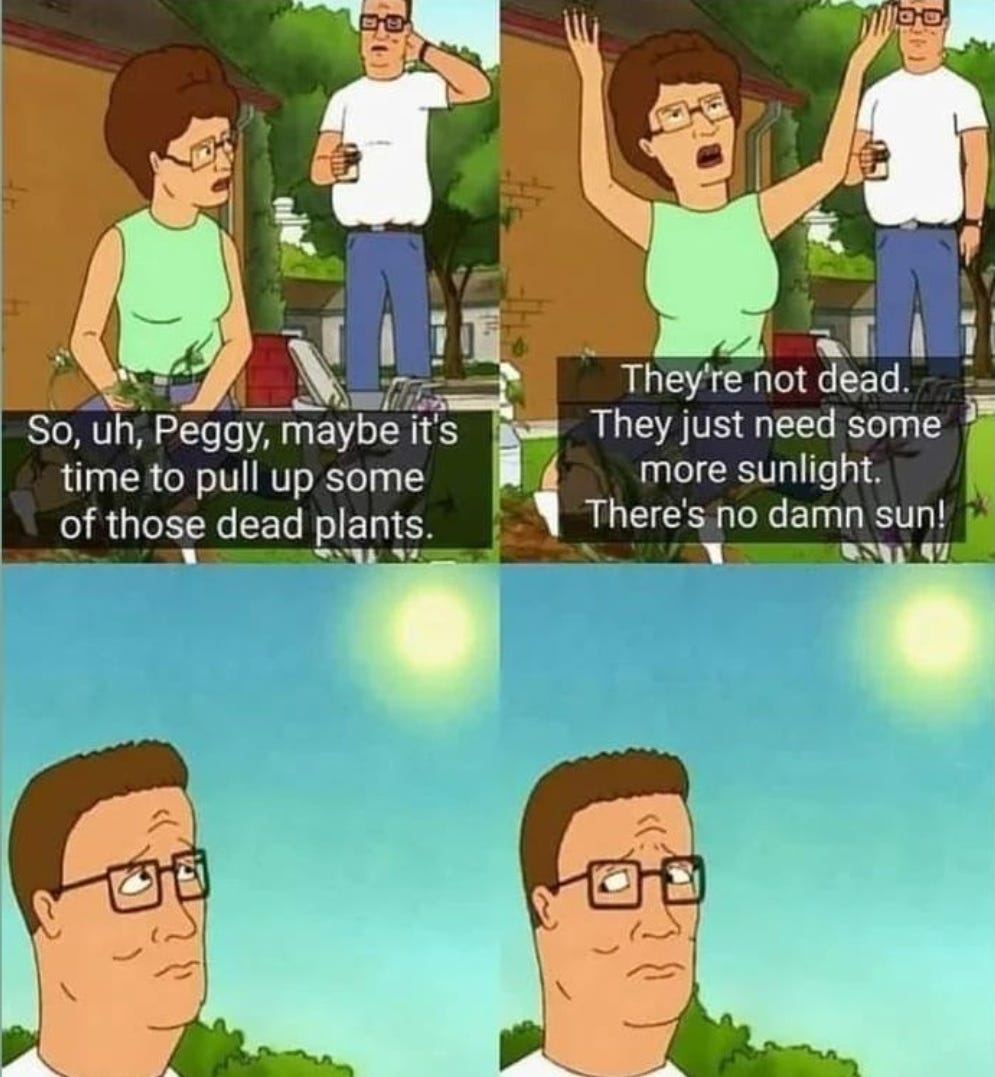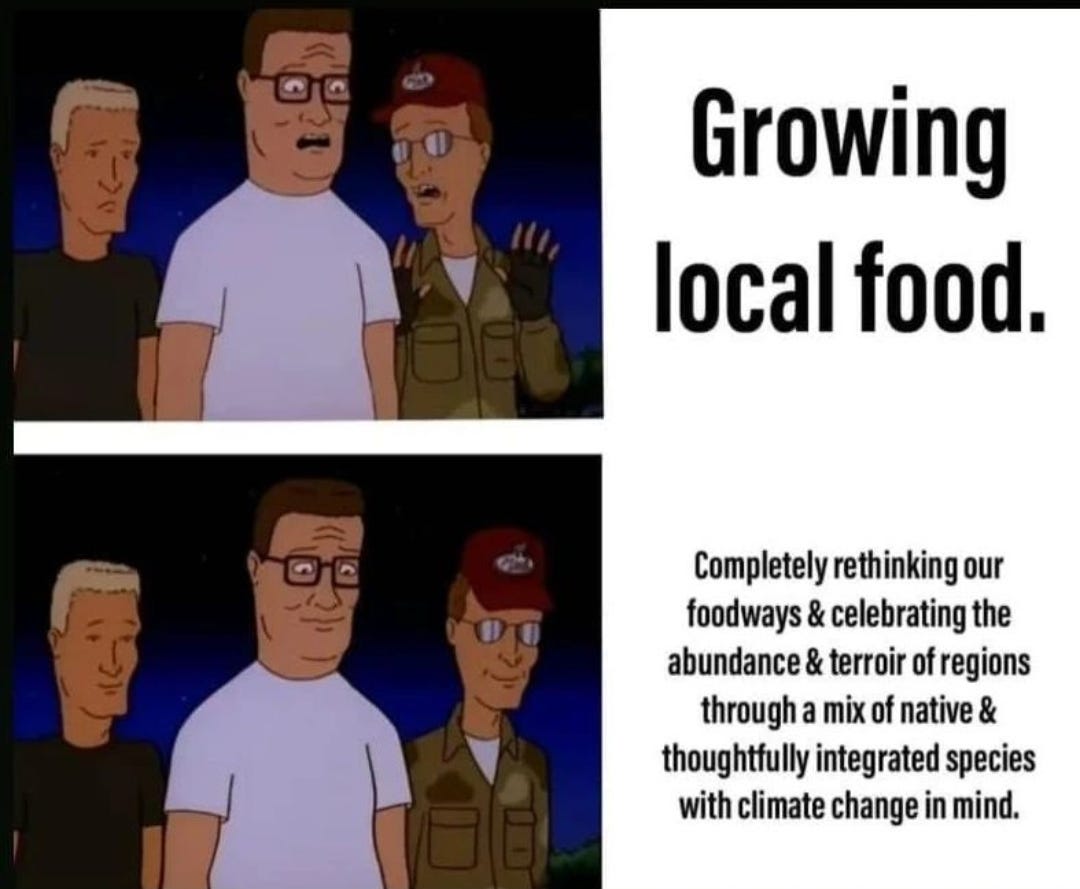In the previous clip, we left off talking about the benefits of cover plants and cover crops. There are a few areas to consider when choosing cover crops-- the largest for folks that are looking for cover cropping over soil after their traditional summer garden is season length and whether or not you get freezing temperatures that may kill certain crops. If you’re looking to cover crop to protect the soil outside of the growing season, giving your cover crops time to grow before your frost is crucial in having it survive the winter and protect your soil.
Further, it’s important to consider your goals—are you trying to build nitrogen or protecting the soil? Is it weed or erosion control? Are you trying to break compaction or add diversity to your entire garden or farm? Maybe all of the above. Either way, depending on which your focus is, your options will be slightly different.
Let’s start with the short fall cover croppings— meaning places with short falls and long winters. Winter rye and other cereals are great cover crops because they grow quickly and will help limit nitrogen leaching. Interseeding to extend the season for your cover crops will be really helpful as well. The idea of interseeding is exactly what it sounds like; seeding your cover crop while your primary crop is still growing, so when your crop is harvested, the cover plants won’t need as much time to grow.
The most common cover crop is probably the clover family— which usually means Red, White, Crimson, Strawberry, and Berseem clover. If you’re looking for native clovers to the US, which I’d recommend first — if you can afford it — Purple Prairie Clover is probably the easiest to find. Clovers are great as a nitrogen fixer, adding up to 200 lbs of nitrogen per acre.1 Further clover works great for grazing, although it can create some bloat in animals if that becomes a large part of their diet, and it’s shade tolerant, which is great for transitional soils, say, in tree stands where you may be coppicing trees and you’re trying to build the ground cover in the shade for rotational grazing goats, cows, etc.
Red, White, and Strawberry clovers are hardy to zone 4, meaning they overwinter extremely well in most of this country, whereas Berseem and Crimson are typically used as winter or summer annuals because they are hardy to zone 7. However, Berseem and Crimson are more drought hardy than the perennials.
Generally, you won’t cover crop with just clover, especially if this will be pasture land. The added benefit of Berseem clover is that it is more tolerant of lower-pH soils, unlike most clovers, so it works better in seeding out a forest understory.
Peas are another legume that do a great job of fixing nitrogen— up to 150 lbs an acre.2 Cowpea and Austrian peas are the ones you’ll typically see as cover crops, and they’re generally an annual— they’re winter hardy to zone 7. Typically, Austrian is planted in the fall for a winter cover crop and Cowpea is planted in the spring. The added benefit of peas is that that they break down quickly, adding the nitrogen quickly to the soil from the decaying plant matter. This is important to remember, because the nitrogen comes primarily from the plant breaking down, not from the plant having lived in the area. When people cover crop soybeans, for example, if you harvest those soybeans, you’ve lost a lot of the nitrogen-fixing benefits of cover cropping— to the point that you can lose more nitrogen year-over-year!3
The best way to understand this is to remember that nitrogen is a key building block of protein, so if you’re removing protein from the landscape, you’re removing nitrogen. And beans and peas are all great sources of protein for humans, so those same beans are drawing tons of nitrogen out of the soil.
Non-Nitrogen-Fixing Cover plants
Winter cereals can also be great at scavenging nitrogen. Winter Rye is a common first cover crop because it’s easy to grow and doesn’t ask for much, but barley, wheat, and triticale are all great at building soil, stopping erosion, being forage for animals, breaking down slowly so they sit and protect the soil long after they die, and having the added bonus of being harvested if you’d like. Again, remember if the seeds are high in protein, you’re removing nitrogen from the soil.
Spring cereals— they’re pretty much the same as the winter cereals— again, rye, wheat, triticale, barley, and the addition of oats. Again, they add nitrogen into the soil, they have quick growth which helps smother weeds, limit erosion, and provide that mulch because they break down slowly. Cereals have a high carbon to nitrogen ratio, so they break down slowly.
In terms of summer annuals, Sorghum sudangrass and buckwheat are the most common. These are used primarily for weed suppression on soils that are resting with the added benefit of being an edible for your animal. These will die off for the winter, but make sure to cut the buckwheat down before it seeds or it will come back the following year and will act like a weed.
In terms of winter annuals, radishes, turnips, and annual ryegrasses are your most common cover crops. They grow quickly, do a great job scavenging nitrogen, breaking up compaction, crowd out weeds, and can be grazed by your chickens, goats, and so on. These will die down for most northern areas, and need to be controlled in zone 6 and higher.
Generally, these different cover crops are used together, intercropped with your primary plant you’re trying to grow, or in succession. Each of these offer unique benefits to your soil and are better fits given what your goals are. For me, personally, I’m working with low-pH soil in a slightly damp location with a bit of shade, and have a bunch of chickens which forage most of their food, so developing cover crops that can help sustain them so that for 8 months of the year they eat little, if any, store-bought food is my ideal situation. I’ll add, it’s not very realistic to try and raise conventional livestock without feed, especially chickens, and while that can be your goal, be WILDLY suspicious of anyone who says they’ve ‘cracked’ the closed loop system. We’ll talk about why this is the case in the near future.
Now let’s move onto crop rotation, which impacts your cover crop decisions. Crop rotation is a great tool because it keeps pests from building up over multiple years at the site of your various crops. Further, the more residues your crops leave in the field, the greater the populations of soil microorganisms, meaning the larger variety of residues from different plants can be left in one site will increase the health of your soil. And, like we said before, some residue takes years to break down, so by rotating crops every, say, 5-7 years (as in, the soil doesn’t see the same plants for 5-7 years) allows the soil to take in all of those different residues, creating healthy, dynamic soil communities.
A few quick thoughts on crop rotation planning, just to get you into the logic of the process. If you plant, say, clover your first your to build your soil, follow it with something that will quickly use that nitrogen—say, tomatoes. The second and third year, go with something that will need less nitrogen to give the soil time to recover, like carrots, or radishes. Stay away from rotating plants in the same family, so in this example, not potatoes, because you don’t want to keep those pests alive. Try to include a deep-rooted crop, such as parsnips, sunflowers, pumpkins, squash, and watermelon, to help bring nutrients up from the subsoil. So for this quick example, you might want 5 beds to cycle the following: Year 1. Sweet corn followed by a hairy vetch/winter rye cover crop Year 2. Pumpkins, winter squash, summer squash followed by a rye or oats cover crop Year 3. Tomatoes, potatoes, peppers followed by a vetch/rye cover crop Year 4. Crucifers, greens, legumes, carrots, onions, and miscellaneous vegetables followed by a rye cover crop Year 5. oats and red clover or buckwheat followed by a vetch/rye cover crop.
So how do you identify cover plants for your fruiting perennials— whether they are bushes, trees, or vines? The key is to identify short, perennial, deep-rooted plants that want the same fungi ratio as your tree. What does that mean? Instead of using perennials that generally might be indicators of transitional space from prairie to shrub land, maybe focus more on understory plants that have lower light requirements than the former. By identifying how the plant functions in an ecosystem, ideally alongside that same primary plant you’re working with, you can find species that have a long, documented history of symbiosis. Taking arbitrary plants, for example comfrey, and growing them because someone recommended the plant without a context, might be a short-term success, but more often than not will fail. Think about all of the fruit trees sold every year at the big box stores. Our suburbs should be swimming in fruit, but they’re not. Almost all of them die within a decade because they’re inappropriate choices for our ecosystems, and haven’t co-evolved with the various predators that exist around them.
So, what does an appropriate co-planting look like? Got some oak trees? You might want to plant some blueberries, huckleberries, witch hazel, pepperbush, or even hazelnut below, depending on the other indicators of the native ecosystem in the space. It’s not just about correlation, but the very specific requirements of that particular spot in terms of water table, mineral makeup, topsoil thickness, and so on. We cannot make good decisions without fundamentally understanding our native ecology first. People are often all-too excited to create food systems without having a proper framework, and make mistakes that they’re too proud to admit later on as their trees get sick, become inaccessible from overplanting, and generally become more work than enjoyment, all in the name of ‘abundance’.
Now, you might be thinking, well you just recommended a whole lot of cover crops that are non-native. Inconsistent much? Cover cropping is expensive, and cover cropping with natives is wildly, financially impractical. That doesn’t mean it’s not worth exploring in the future. Further, when we’re talking about annuals and short-lived perennials, they generally won’t have as much of an ecosystem impact as the wrong tree being planted.
Now, can we try to use short-growing understory plants in our annual gardens? It has been done in practice. Creating small rows where your tomatoes and other annuals can grow between low-growing perennials allows you to limit soil disruption, while limiting challenges with wet, muddy spring plantings, and the complex root systems in place can help in years when spring rains can mean a ruined crop. In dry seasons, the green cover will protect the soil from drying out, and can reduce water use by 70%.4 Expect that these perennials will get beaten up; after all, they’re being stepped on while you’re doing plantings, make sure that cover crop can handle that.
So what our options for perennial cover crops for annual gardens, where the fungi to bacteria ratio should be just 1:1? I’ll list the ones I’ve found, with a huge thank-you to Dr. Elaine Ingham for her contribution for the west coast list: Creeping Daisy, Silver Carpet, Matted Buckwheat, Spotted Spurge, Virginia Strawberry, Parry’s Horkelia, Red Monardella, California Evening Primrose, Hobbit Toes, Yerba Buena,Silver Moon, Shaggy-Haired Alumroot, Brownheaded Rush, baby blue eyes, and Sierra Beardtongue for the warmer west coast, and for the east coast, low-growing Feverfew (‘White Stars’ being a lower growing option), creeping thyme, violet, queen charlotte, Cowslip, oregano, Shooting star, Goldfink, Blue Butterfly Delphinium, Creeping Sedum, Kahori Dianthus (or really any Dianthus), Vetch and red and white clover can be treated as a perennial, although I’m a bit more hesitant of whether or not it meets the fungi requirements. Of these, the legumes are the only ones who have documented nitrogen-fixing capacity. Sorry middle America-- you can try either of these, I’m not knowledgeable enough to jump in there.
When we plant perennials, versus annual cover crops, the perennials build bigger root systems and spend less time long-term building those root systems. What we get in return, over the long-term, is that they are pushing more nutrients into the soil— up to 40% of the energy created from photosynthesis— they are aerating deeper into the soil, and they come with the added benefit that it’s less work for us!5
To circle back to the conversation earlier about how we’ve destroyed our soil, while on average conventional farming erodes the soil at 1.54 milimeters a year, returning it to nature allows the soil to grow at .01mm a year, and no-till farming using annual and perennial cover crops actually increases soil content at .08 milimeters a year.6 There are two interesting facts here; the first is that, I know, that seems wrong that farming land in a no-till fashion actually builds soil faster than nature, but it’s been documented in over 200 studies, and it’s a glimmer of hope for all of us. This is because we're utilizing inputs; adding composts and cardboard and mulch all adds material that wouldn't naturally be there. The second is that the average loss from traditional plow-farming at 1mm a year would clear roughly 2-3 feet in 500-1000 years, which, if you've ever looked at topsoil loss images from the dustbowl, is absolutely frightening.

Part of the challenge of maintaining soils today is that the nutrient cycle has been completely eliminated from its natural state— traditionally, folks lived closed to their food. This meant that they grew the plants, consumed them, and the nutrients returned to the soil locally. Yes. I’m talking about the poop loop. Even up until the 18th and into the 19th century, shit was was literally shipped back to farmers to be used for farming.7 I know that sounds ridiculous and made up, but it’s 100% true and you should definitely look into it.
Once industrialization happened and urban cities grew exponentially in a short period of time, cities developed more modern sewage systems and the need to ship shit away became less of an issue. Concurrently, modern fertilizers were taking hold, so farmers were conveniently replacing human manure with synthetic fertilizers, which I totally get seeing as a huge upgrade. Over the past 70 years, we have taken this more recent industrial model and put it on speed, and our increased meat consumption has created a secondary shit market, which has created countless water safety issues, dead zones in waterways, among other issues.
We have two seemingly opposite issues going on here, right? Massive animal farms have a massive output problem, while massive grain farmers, for example, have a massive input problem. We have spent some time talking about how great some cover crops are for things like nitrogen fixation, but for context, an acre of tomato plants pulls over 100 pounds of nitrogen, 20 pounds of phosphorus, and 100 pounds of potassium out of the soil for that production. The soil needs 1 year to recover from producing those tomatoes just to regain its nitrogen. On the flip side of this, a typical dairy farm brings in almost 80% of its feed from outside of the farm, and 60% of the nitrogen in the feed given to the cows is excreted as waste on the farm— way more than that land can use or absorb, leading to runoff and leaching problems. By trying to create linear systems for growing food, we are operating the opposite way of nature, and further, by shipping foods across the globe, we are creating imbalances in regards to soil health where the loss of organic soil matter is being supplemented with chemical fertilizers.
By creating those localized networks of farmers, where they are able to specialize but retain connections with other local farms to keep these nutrient networks in place, we will be able to create sustainable nutrient flows for healthier soils.
So I want to go back to the conversation about global warming again, particularly the fact that currently, because of the destruction of the complex systems on the planet on a massive scale, we are currently in an entropic state, losing 10% of the energy from the sun. When we look at building soil, we are harnessing the plants and organic matter from animals to build the soil for new plants— we are trapping the energy in the plants within the soil. All of the life in the soil comes from our ability to retain the energy from the sun—and in this way, in building soil we are building the foundation for a sustainable planet. Even if that soil does not provide food, it provides the necessary storage of energy for the planet’s survival. This is why cover crops are so impactful— it keeps the sun’s energy in the soil and provides the framework for all biological life for the soil.
The Graze Gaze
Let’s keep talking about shit. Specifically, pasture fields and the shit that happens in them— literally and figuratively. All of us are familiar with the image of the local farm— a cow is nestled on the edge of a wooden fence, slowly chowing on some grasses. There’s a few cows in the distance, but they don’t seem to have a care in the world. You imagine that cow stands there every afternoon to watch the cars pass by during rush hour and catch a breeze on a hot summer day. Well, the cow’s relationship with the field is complicated. Not in the way your uncle and his girlfriend slash ex-sister in law is, but it’s still not as simple as it might seem.
There are, generally speaking, three primary ways that cow eats the grass on the field. Continuous grazing is when this cow stays in the same 4 gates his entire life and eats some of it at a time and the grass grows fast enough he never kills it all— this is what most people are picturing in their picaresque farmlife. Second, there’s the slow rotation grazing most folks are familiar with. The cows spend a season in one part of the field, then they get moved to another part of the field for another part of the season. Last is adaptive high stock density grazing, which is closer to what you think of when you envision bison roaming the midwest. There a ton of them close together, not trying to die by being outside of the herd, and they’re all eating in one spot for a little while, and then they move as a group to another spot once that one is depleted. Using the last type of farming, what we can just call intensive grazing, people have claimed some proposterious amounts of benefits, while studies seem to be inconsistent in proving the soil increases are remotely close to the claims of folks like Allan Savory.8 Some studies even suggest that intensive grazing has negative impacts to soil health! 9
I would argue that the disconnect in these discussions are likely because of the cycling of the material within the cows. Simply put, if you're grazing more animals on a landscape, and we understand that livestock are 'carrying' some of the energy in the soil through simply existing, then there's a larger 'pending' nutrient dump to go back into the soil. If you were to think of it as bulk-purchasing; buying the 24 pack of toilet paper up front is going to save you money in the long-run, but if you're always buying that 24 pack before you run out, you never get to the point where it 'nets out'. That doesn't mean Savory isn't WILDLY overselling the benefits of intensive grazing. We'll talk more about that in the future.
The takeaway is that it’s complicated, and folks can find evidence of basically whatever they want when it comes to grazing practices. Advocates say that intesnive grazing not only doubes the amount of organic matter in the soil, they’re getting the organic matter deeper into the soil at a rate 3x of traditional continuous grazing. Grazing as a general rule increases grass production— in traditional grazing, it increases production to 44%, and intensive grazing increases production up to 138%, based on a study by the state of New York (sorry, since I wrote this episode I can’t seem to find this particular study).
One of the ways this works is pretty simple— by controlling what the animals, in this case, cows— can eat, you’re creating what’s called the buffet effect. While in a larger paddock, the cows might pick and choose their favorite grasses to eat— and this can lead to some spots that are overgrazed and some spots that are under grazed, both of which can have problems for your field. When they have a smaller area, they have to eat everything— including the weeds they don’t want to necessarily eat even though they are nutritious. Further, by creating dense clusters of animals, there’s more animal impact from their feet, helping seeds get into the soil and increasing germination, further protecting the soil from nutrient loss and increasing biomass for animals to eat. The impact of their feet is probably the most questionable part of the claims made in defense of intensive grazing, and there’s been very little evidence to support this theory, at the time of this writing. Ultimately, by creating more, short-term spaces for the cows to graze, you’re extending the grow time for the grasses before they are grazed again as well, increasing the paddock’s capacity to grow the grass as well.
Now, for most of the United States, you need between 1-5 acres of land to maintain 1000 pounds of animal. 1 acre is likely going to be the person doing intensive grazing in a moist, warmer climate— even something like coastal new England. By getting more productivity out of a smaller space, we are able to keep food production closer to home, which is especially valuable if we can do so in a way that mimics the natural process in nature, more specifically the local ecosystems where we currently live.
By understanding the relationship between the sun, the organic matter in the soil, the plants, and animals, we can see how all of these things relate to one another and ultimately how each of them depends on the others to be successful in efficiently converting energy into meaningful life. As stewards of our patch of land, whether it’s a planter or acreage, it becomes evident how we can help develop sustainable, self-supporting systems with limited long-term input from us while also creating a more habitable community.
If you’ve enjoyed this piece, which is equal to a 16 page chapter, of (so far) an 83 page book with 60 sources, you can support our work a number of ways. The first is by sharing this article with folks you think would find it interesting. The second is by listening and sharing the audio version of this content, the Poor Proles Almanac podcast, available wherever you get your podcasts. If you’d like to financially support the project, and get exclusive access to our limited paywalled content, you can subscribe on Substack or Patreon, which will both give you access to the paywalled content, and in the case of Patreon, early access to the audio episodes as well.
https://www.uaex.uada.edu/publications/pdf/FSA-2160.pdf
https://extension.okstate.edu/fact-sheets/forage-legumes-and-nitrogen-production.html
https://www.canr.msu.edu/news/nutrient_removal_rates_by_grain_crops#:~:text=Likewise%2C%20a%2040%2Dbushel%2D,per%20acre%20K20.
https://www.sare.org/wp-content/uploads/Tellatin-Superheroes-of-the-Soil.pdf
https://www.pnas.org/doi/10.1073/pnas.1008779108
Ingham, E. (2016, May 11). Building Soil Health for healthy plants by soil scientist dr. Elaine Ingham. YouTube. Retrieved February 3, 2023
https://www.atlasobscura.com/articles/when-american-cities-were-full-of-crap
https://www.sierraclub.org/sierra/2017-2-march-april/feature/allan-savory-says-more-cows-land-will-reverse-climate-change
(PDF) investigation on changes in soil organic matter and nutrient ... (n.d.). Retrieved February 4, 2023, from https://www.researchgate.net/publication/319242272_Investigation_on_changes_in_soil_organic_matter_and_nutrient_elements_under_various_grazing_intensities_Case_study_Chaharbagh_mountain_rangelands_of_Golestan_province











